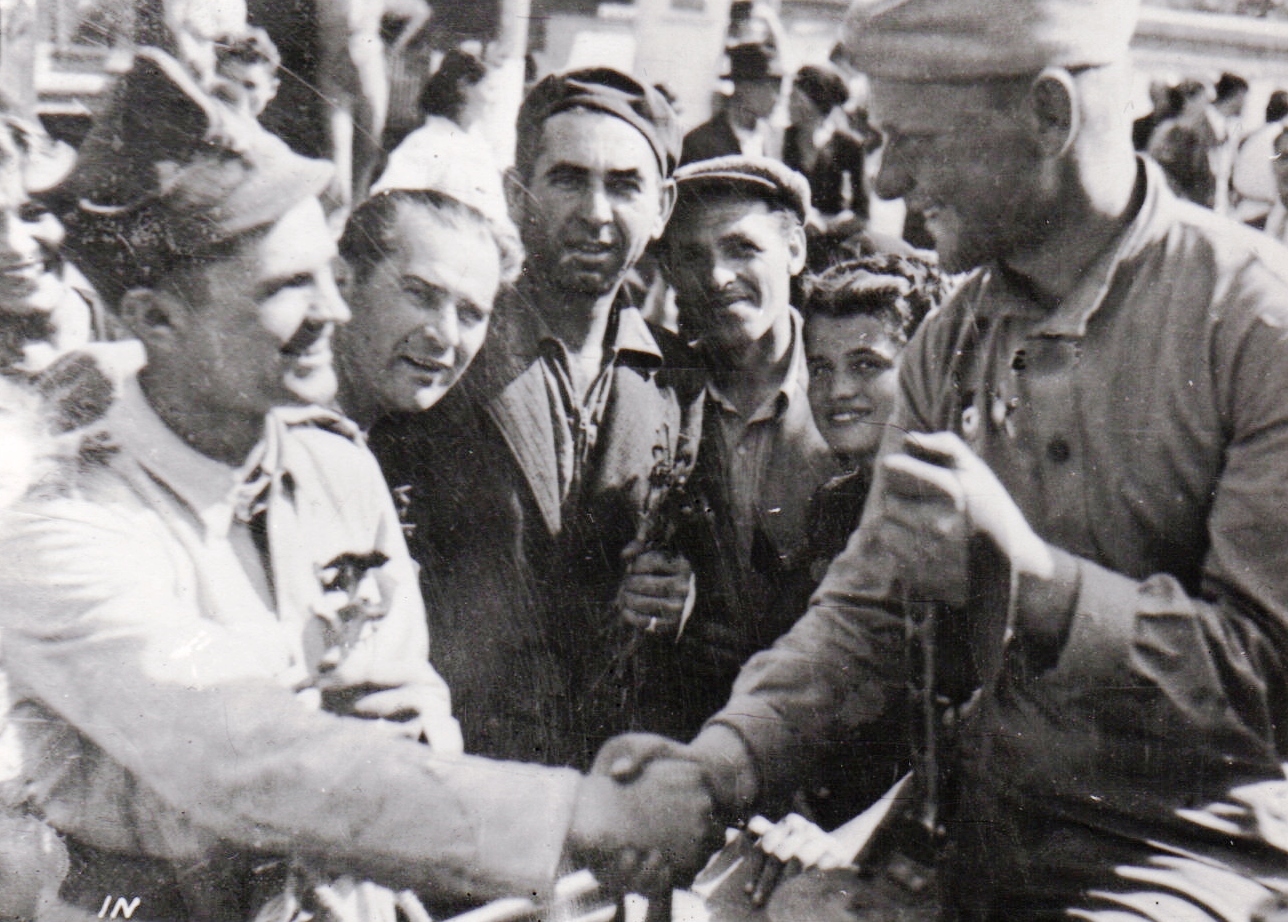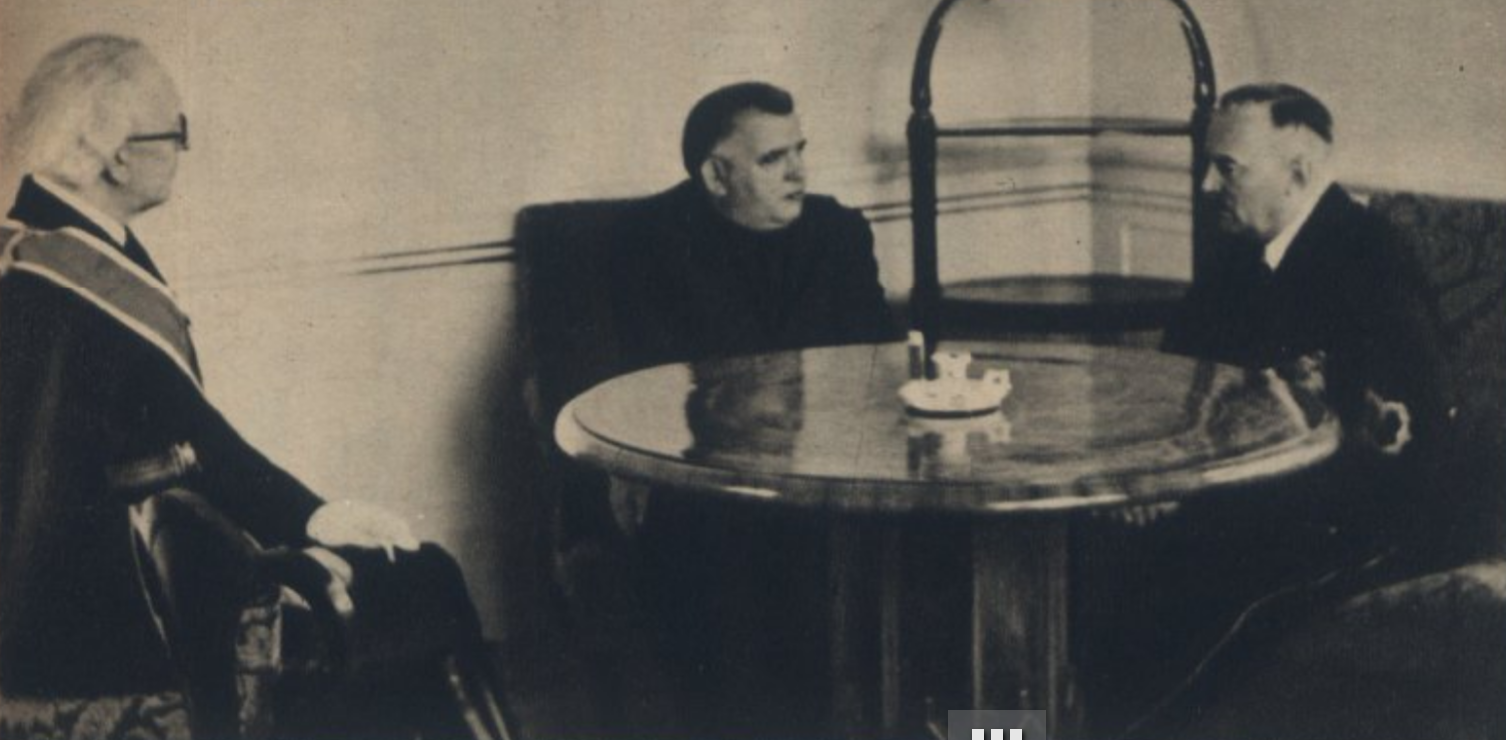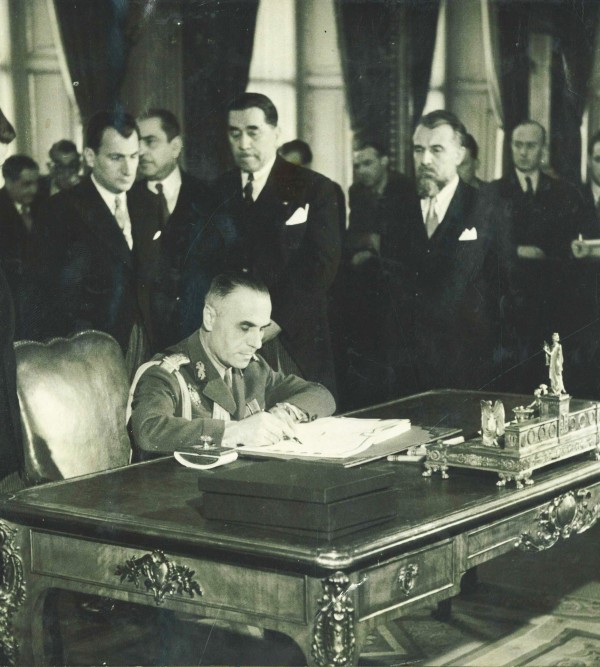|
1944 Romanian Coup D'état
The 1944 Romanian coup d'état, better known in Romanian historiography as the Act of 23 August ( ro, Actul de la 23 August), was a coup d'état led by King Michael I of Romania during World War II on 23 August 1944. With the support of several political parties, the king removed the government of Ion Antonescu, which had aligned Romania with Nazi Germany, after the Axis front in northeastern Romania collapsed in the face of a successful Soviet offensive. The Romanian Army declared a unilateral ceasefire with the Soviet Red Army on the Moldavian front, an event viewed as decisive in the Allied advances against the Axis powers in the European theatre of World War II. The coup was supported by the Romanian Communist Party, the Social Democratic Party, the National Liberal Party, and the National Peasants' Party who had coalesced into the National Democratic Bloc in June 1944. Preparations According to Silviu Brucan, the two main conspirators from the Communist Party's side were ... [...More Info...] [...Related Items...] OR: [Wikipedia] [Google] [Baidu] |
Michael I Of Romania
Michael I ( ro, Mihai I ; 25 October 1921 – 5 December 2017) was the last King of Romania, reigning from 20 July 1927 to 8 June 1930 and again from 6 September 1940 until his forced abdication on 30 December 1947. Shortly after Michael's birth, his father, Crown Prince Carol of Romania, had become involved in a controversial relationship with Magda Lupescu. In 1925, Carol was pressured to renounce his rights to the throne and moved to Paris in exile with Lupescu. In 1927, Michael ascended the throne, following the death of his grandfather King Ferdinand I. As Michael was still a minor, a regency council was instituted, composed of his uncle Prince Nicolae, Patriarch Miron Cristea and the president of the Supreme Court, Gheorghe Buzdugan. The council proved to be ineffective and, in 1930, Carol returned to Romania and replaced his son as monarch, reigning as Carol II. As a result, Michael returned to being heir apparent to the throne and was given the additional title of G ... [...More Info...] [...Related Items...] OR: [Wikipedia] [Google] [Baidu] |
National Liberal Party (Romania, 1875)
The National Liberal Party ( ro, Partidul Național Liberal, PNL) was the first organised political party in Romania, a major force in the country's politics from its foundation in 1875 to World War II. Established in order to represent the interests of the nascent local bourgeoisie, until World War I it contested power with the Conservative Party, supported primarily by wealthy landowners, effectively creating a two-party system in a political system which severely limited the representation of the peasant majority through census suffrage. Unlike its major opponent, the PNL managed to preserve its prominence after the implementation of universal male suffrage, playing an important role in shaping the institutional framework of ''Greater Romania'' during the 1920s. History Dominated throughout its existence by the Brătianu family, the party was periodically affected by strong factionalism. Among the many splits during the party's early history a notable one was that led ... [...More Info...] [...Related Items...] OR: [Wikipedia] [Google] [Baidu] |
Mihai Antonescu
Mihai Antonescu (18 November 1904 – 1 June 1946) was a Romanian politician who served as Deputy Prime Minister of Romania, Prime Minister and List of Foreign Ministers of Romania, Foreign Minister during World War II, executed in 1946 as a war criminal. Early career Born in Nucet, Dâmbovița, Nucet, Dâmbovița County, went to school in Pitești, and then at the Saint Sava National College in Bucharest. From 1922 to 1926 he attended the Faculty of Law of the University of Bucharest. Antonescu made his living as an Lawyer, attorney before becoming the Minister of Foreign Affairs to Prime Minister Ion Antonescu (to whom he was not closely related) in 1940. Antonescu was initially not an extremism, extremist or supporter of the Iron Guard, whose leaders held prominent positions in Ion Antonescu's government in 1940-1941 (''see National Legionary State''); in the 1930s, he was a member of the National Liberal Party-Brătianu. As a minister, he drifted to the far right, and esta ... [...More Info...] [...Related Items...] OR: [Wikipedia] [Google] [Baidu] |
Gestapo
The (), abbreviated Gestapo (; ), was the official secret police of Nazi Germany and in German-occupied Europe. The force was created by Hermann Göring in 1933 by combining the various political police agencies of Prussia into one organisation. On 20 April 1934, oversight of the Gestapo passed to the head of the ''Schutzstaffel'' (SS), Heinrich Himmler, who was also appointed Chief of German Police by Hitler in 1936. Instead of being exclusively a Prussian state agency, the Gestapo became a national one as a sub-office of the (SiPo; Security Police). From 27 September 1939, it was administered by the Reich Security Main Office (RSHA). It became known as (Dept) 4 of the RSHA and was considered a sister organisation to the (SD; Security Service). During World War II, the Gestapo played a key role in the Holocaust. After the war ended, the Gestapo was declared a criminal organisation by the International Military Tribunal (IMT) at the Nuremberg trials. History After Adol ... [...More Info...] [...Related Items...] OR: [Wikipedia] [Google] [Baidu] |
Ion Gigurtu
Ion Gigurtu (; 24 June 1886 – 24 November 1959) was a far-right Romanian politician, Land Forces officer, engineer and industrialist who served a brief term as Prime Minister from 4 July to 4 September 1940, under the personal regime of King Carol II. A specialist in mining and veteran of both the Second Balkan War and World War I, he made a fortune in interwar Greater Romania. Gigurtu began his career in politics with the People's Party (PP) and the National Agrarian Party, moving closer to the far right during the 1930s, and serving as Minister of Industry and Commerce in the cabinet of Octavian Goga. Shortly after the start of World War II, Gigurtu was affiliated with King Carol's National Renaissance Front, serving as Public Works and Communications Minister and Foreign Minister under Premier Gheorghe Tătărescu, before the territorial losses incurred by Romania in front of the Soviet Union propelled him as Tătărescu's replacement. Gigurtu's executive was primarily not ... [...More Info...] [...Related Items...] OR: [Wikipedia] [Google] [Baidu] |
Manfred Freiherr Von Killinger
Manfred Freiherr von Killinger (July 14, 1886 – September 2, 1944) was a German naval officer, ''Freikorps'' leader, military writer and Nazism, Nazi politician. A veteran of World War I and member of the ''Marinebrigade Ehrhardt'' during the German Revolution, he took part in the military intervention against the Bavarian Soviet Republic. After the ''Freikorps'' was disbanded, the Antisemitism, antisemitic Killinger was active in the ''Germanenorden'' and ''Organisation Consul'', masterminding the murder of Matthias Erzberger. He was subsequently a Nazi Party representative in the Reichstag (German Empire), Reichstag and a leader of the ''Sturmabteilung'', before serving as Saxony's List of Ministers-President of Saxony, Minister-President and playing a part in implementing Nazi policies at a local level. Purged during the Night of the Long Knives, he was able to recover his status, and served as Nazi Germany's Consul (representative), Consul in San Francisco between 1936 an ... [...More Info...] [...Related Items...] OR: [Wikipedia] [Google] [Baidu] |
Grigore Niculescu-Buzești
Grigore Niculescu-Buzești (August 1, 1908 – October 4, 1949) was a Romanian politician who served as the Minister of Foreign Affairs of Romania. Niculescu-Buzești was one of the founding members of Romanian National Committee (''Comitetul Național Român''), an organization which claimed to be a Romanian government in exile. He was also one of the participants in the plot against the Romanian Nazi-collaborating dictator Ion Antonescu organized by the King Michael of Romania. Niculescu-Buzești died on October 12, 1949 in New York City. See also *Foreign relations of Romania The foreign relations of Romania are conducted by the Ministry of Foreign Affairs (''Ministerul Afacerilor Externe''; MAE). Romania is a member of NATO and the European Union. Diplomatic list List of countries which Romania maintains diplomatic ... References Romanian Ministers of Foreign Affairs 1908 births 1949 deaths People from Sarata {{Romania-bio-stub ... [...More Info...] [...Related Items...] OR: [Wikipedia] [Google] [Baidu] |
Mircea Ionnițiu
Mircea Ionnițiu (sometimes incorrectly spelled "Ioanițiu" or "Ioannițiu") (born date unknown, Bucharest – November 13, 1990, Woodland Hills, California, United States) was a Romanian writer, author of memorial notes. In his adolescence, he was a member of the Palatine Class, a special class of pupils that was formed upon the request of King Carol II of Romania, for the education of his only son, Prince Michael (proclaimed king as Michael I in 1940). Around 1944, Mircea Ionnițiu was a personal secretary of King Michael I. In this job, he was a direct witness of the August 23rd events, of the imposition of the first Petru Groza cabinet through Soviet pressure (March 6, 1945) and of the king's forced abdication on December 30, 1947. Mircea Ionnițiu left Romania on January 3, 1948, in the Royal Train, together with the Royal Family of Romania that was departing in forced exile Exile is primarily penal expulsion from one's native country, and secondarily expatriati ... [...More Info...] [...Related Items...] OR: [Wikipedia] [Google] [Baidu] |
Dumitru Dămăceanu
Dumitru Dămăceanu (17 July 1896 – 27 September 1978) was a Romanian army officer in World War II, later promoted to brigadier-general, who played a predominant role in the royal coup of August 23, 1944. Military and diplomatic career Before World War II Dămăceanu was born in the village of Cosmești, in Galați County, Romania. He attended the Costache Negruzzi Boarding High School of Iași, and then the Military School for Cavalry Officers in Târgoviște, graduating in 1916 with the rank of second lieutenant. He then fought in the Romanian campaign of World War I with the 6th Regiment '' Roșiori''. After the war, he pursued his military education at Infantry Officer School in Sibiu (1923) and the Military Academy of Turin (1929). In between the world wars, he was military attaché in Rome, Italy, director at the Voievodul Mihai School, and adjutant to King Carol II. He was promoted to lieutenant colonel in 1938 and colonel in 1940. During World War II From 194 ... [...More Info...] [...Related Items...] OR: [Wikipedia] [Google] [Baidu] |
Gheorghe Mihail
Gheorghe Mihail (March 13, 1887 – January 31, 1982) was a Romanian career army officer. Born in Brăila, he completed primary school in 1902 and passed an examination to enter the school for soldiers' sons in Iași, taking years 7 and 8 there.Neagoe, pp. 92–3 He attended the military school for active-duty infantry officers between 1905 and 1907. Made a second lieutenant in 1907, he advanced to lieutenant in 1910. In 1911, he won a competition for a specialized training with the Austro-Hungarian Army, enrolling in the seventh infantry division at Esseg for two years. During vacation time, he was able to undertake trips to Berlin, Breslau, Venice, Paris, and Rome, attend maneuvers in Belgium and Switzerland, and spend a month in Egypt during the winter of 1910–1911. After returning home in the summer of 1913, he was mobilized for the Second Balkan War. His infantry regiment did not cross the Danube into Bulgarian territory, but instead guarded the capital Bucharest from Tunari ... [...More Info...] [...Related Items...] OR: [Wikipedia] [Google] [Baidu] |
Calea Moșilor
Calea Moșilor (, ''Moșilor Avenue'') is both a historic street and a major road in Bucharest, Romania. It runs from the back of the Cocor Shopping Mall (near Piața Unirii) to Obor. The street is divided into two distinct parts. East of the intersection with Carol I Boulevard the street has two lanes and consists of apartment blocks built during the communist era, while West of the intersection with Carol I Boulevard the street has only one lane and consists of houses built in the 19th century. History The old name of Calea Moșilor is Podul Târgului din Afară which translated means ''The Bridge of Outside Fair'' (also ''market'' or even ''field''), referring to a big fair held outside the city. Why "the Bridge" (Romanian: ''pod'')? Probably because all main roads in medieval Bucharest were "paved" with wood and had a resemblance to a bridge. In any case, ''pod'' was a common name for a major road in Wallachia into the 19th Century. For example, Calea Victoriei was once known ... [...More Info...] [...Related Items...] OR: [Wikipedia] [Google] [Baidu] |
Lucrețiu Pătrășcanu
Lucrețiu Pătrășcanu (; November 4, 1900 – April 17, 1954) was a Romanian communist politician and leading member of the Communist Party of Romania (PCR), also noted for his activities as a lawyer, sociologist and economist. For a while, he was a professor at the University of Bucharest. Pătrășcanu rose to a government position before the end of World War II and, after having disagreed with Stalinist tenets on several occasions, eventually came into conflict with the Romanian Communist government of Gheorghe Gheorghiu-Dej. He became a political prisoner and was ultimately executed. Fourteen years after Pătrășcanu's death, Romania's new communist leader, Nicolae Ceaușescu, endorsed his rehabilitation as part of a change in policy. Early life Pătrășcanu was born in Bacău to a leading political family, as the son of Poporanist figure Dimitrie D. Pătrășcanu (Lucrețiu's mother, Lucreția, was a scion of the Stoika family of Transylvanian petty nobility). He beca ... [...More Info...] [...Related Items...] OR: [Wikipedia] [Google] [Baidu] |







